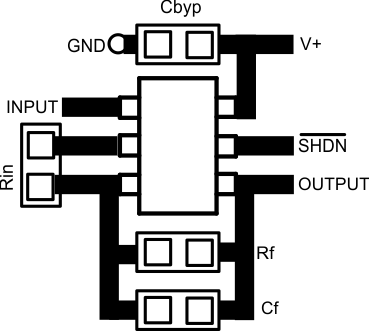SNOSC70C April 2012 – July 2016 LMV601 , LMV602 , LMV604
PRODUCTION DATA.
- 1 Features
- 2 Applications
- 3 Description
- 4 Revision History
- 5 Pin Configuration and Functions
-
6 Specifications
- 6.1 Absolute Maximum Ratings
- 6.2 ESD Ratings
- 6.3 Recommended Operating Conditions
- 6.4 Thermal Information
- 6.5 Electrical Characteristics - DC (2.7 V)
- 6.6 Electrical Characteristics - AC (2.7 V)
- 6.7 Electrical Characteristics - DC (5 V)
- 6.8 Electrical Characteristics - AC (5 V)
- 6.9 Typical Characteristics
- 7 Detailed Description
- 8 Application and Implementation
- 9 Power Supply Recommendations
- 10Layout
- 11Device and Documentation Support
- 12Mechanical, Packaging, and Orderable Information
Package Options
Mechanical Data (Package|Pins)
Thermal pad, mechanical data (Package|Pins)
Orderable Information
10 Layout
10.1 Layout Guideline
To properly bypass the power supply, consider the placement of several components on the printed-circuit boad. A 6.8‑µF or greater tantalum capacitor must be placed at the point where the power supply for the amplifier is introduced onto the board. Another 0.1-µF ceramic capacitor must be placed as close as possible to the power supply pin of the amplifier. If the amplifier is operated in a single power supply, only the V+ pin must be bypassed with a 0.1-µF capacitor. If the amplifier is operated in a dual power supply, both V+ and V– pins must be bypassed.
It is good practice to use a ground plane on a printed-circuit board to provide all components with a low inductive ground connection.
TI recommends surface-mount components in 0805 size or smaller in the LMV601-N application circuits. Designers can take advantage of the VSSOP miniature sizes to condense board layout to save space and reduce stray capacitance.
10.2 Layout Example
 Figure 48. PCB Layout Example
Figure 48. PCB Layout Example